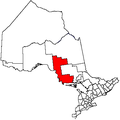External links
| Lake Superior Region | |
|---|---|
| Lake Huron Region |
|
| Southwest Region | |
| Southeast Region | |
| Robinson Superior Treaty, 1850 | |
|---|---|
| Robinson Huron Treaty, 1850 | |
| Saugeen Surrenders, 1854 | |
| Pennefather Treaty, 1859 | |
| |
| Cities | ||
|---|---|---|
| Towns | ||
| Townships | ||
| Villages | ||
| First Nations | ||
| Indian reserves | ||
| Unorganized areas | ||
| Local services boards | ||
| Unincorporated communities |
| |
| Towns | ||
|---|---|---|
| Townships | ||
| First Nations | ||
| Indian reserves | ||
| Unorganized area | ||
| Local services boards | ||
| | This First Nations in Canada–related article is a stub. You can help Wikipedia by expanding it. |

